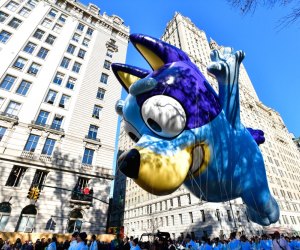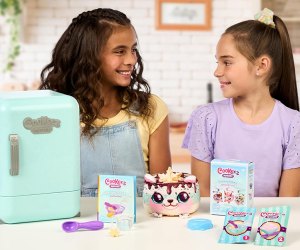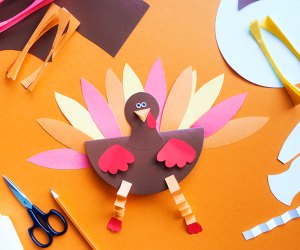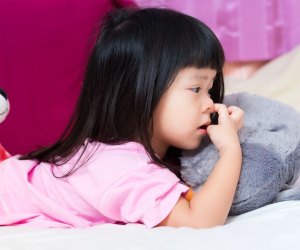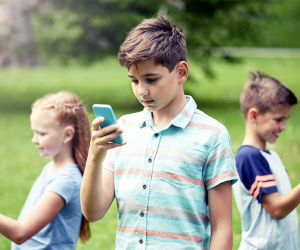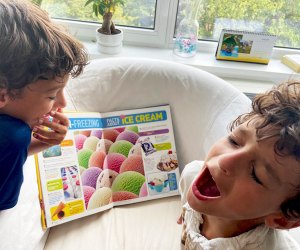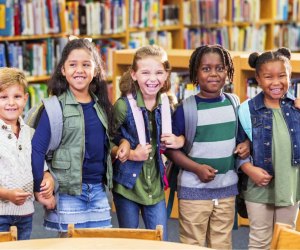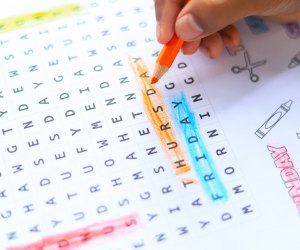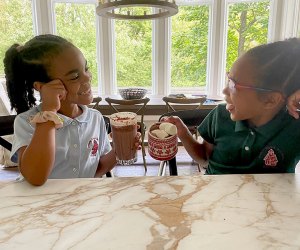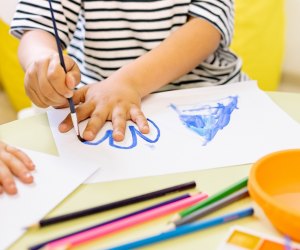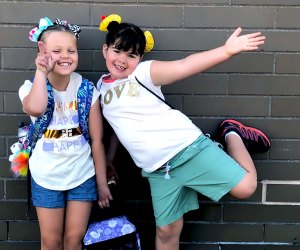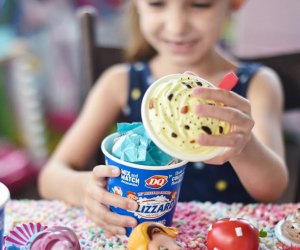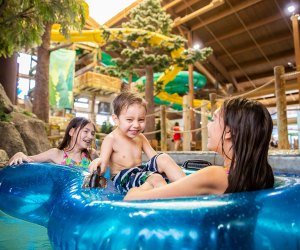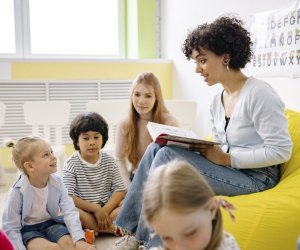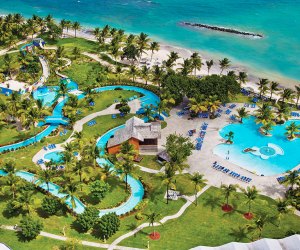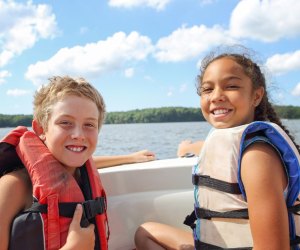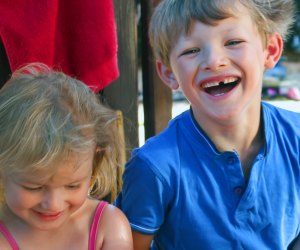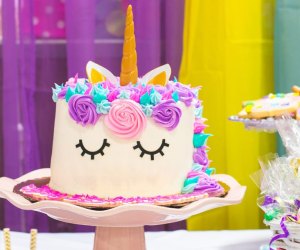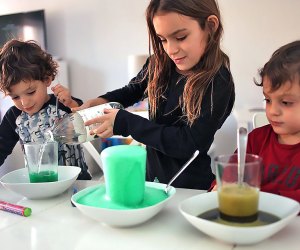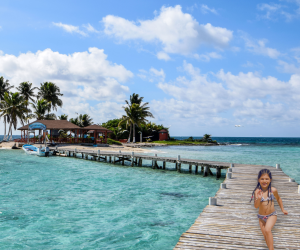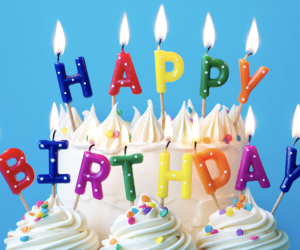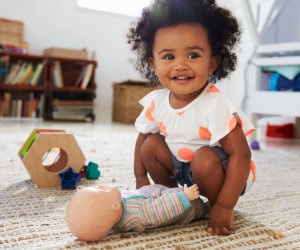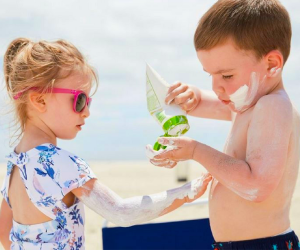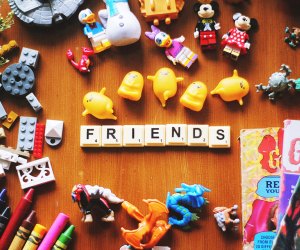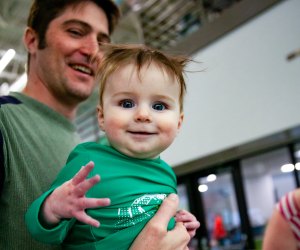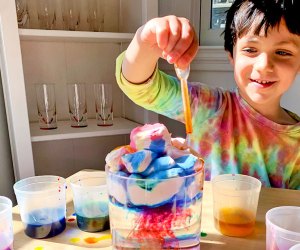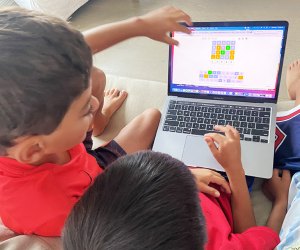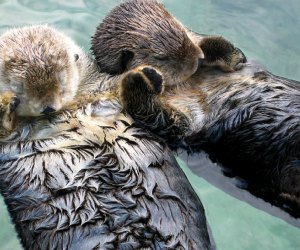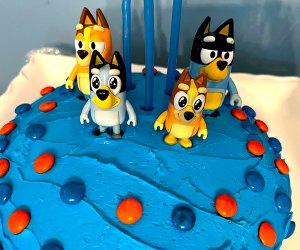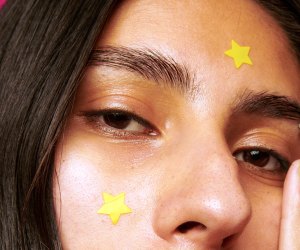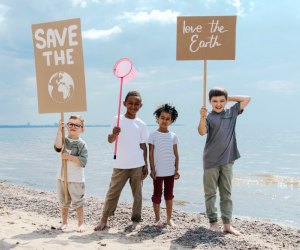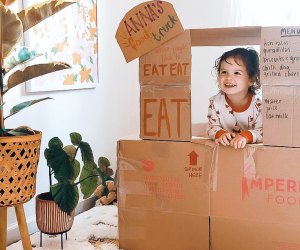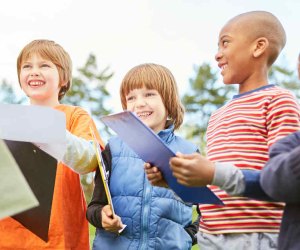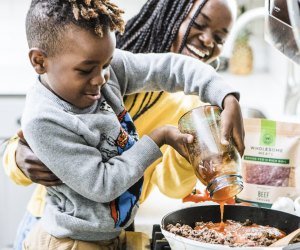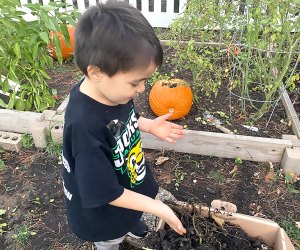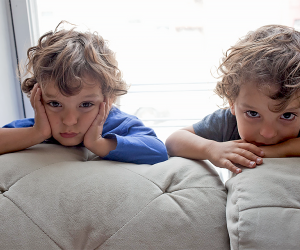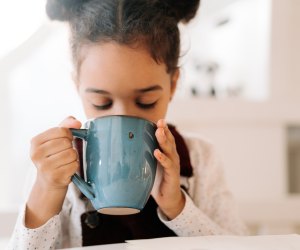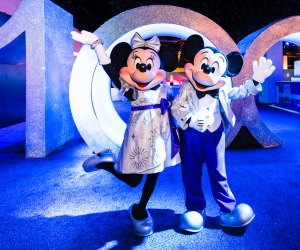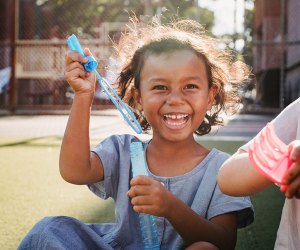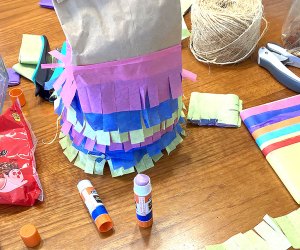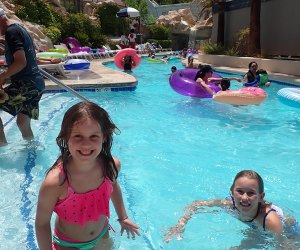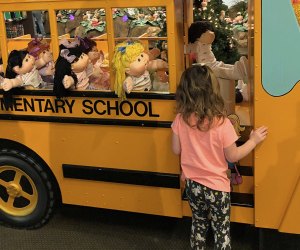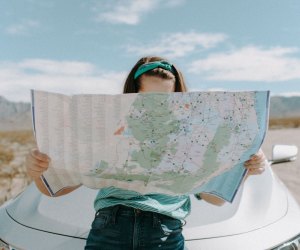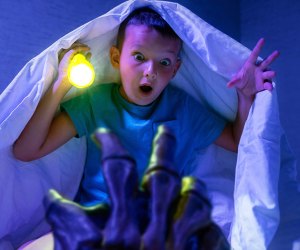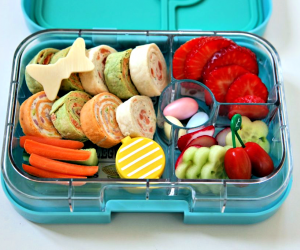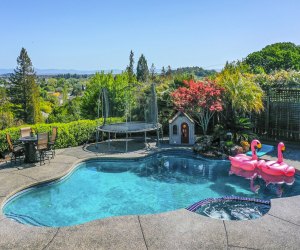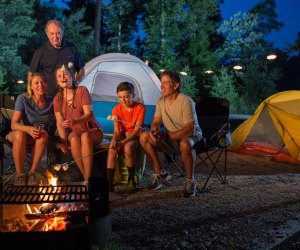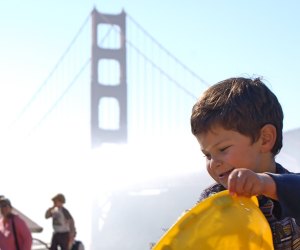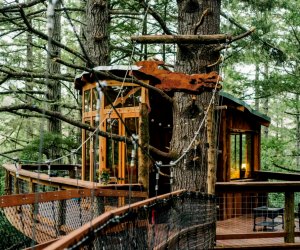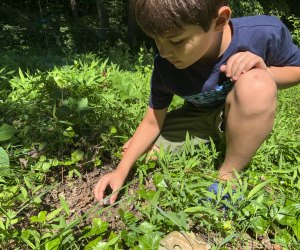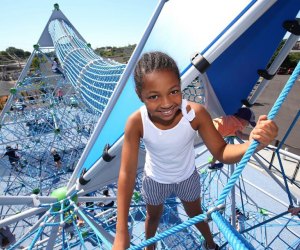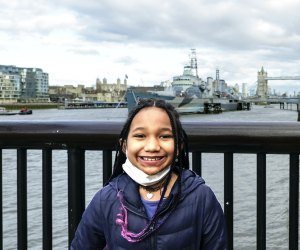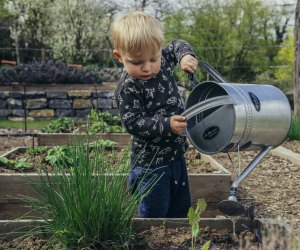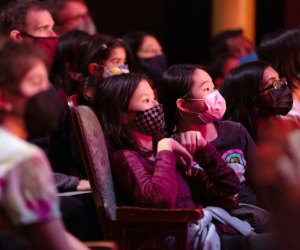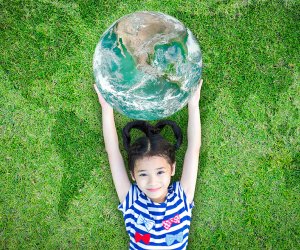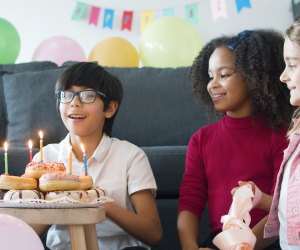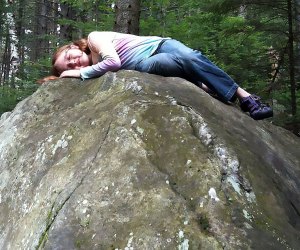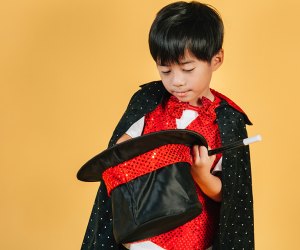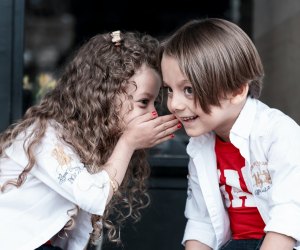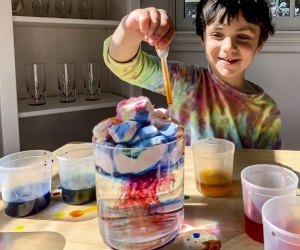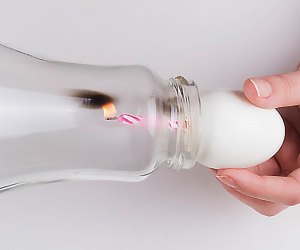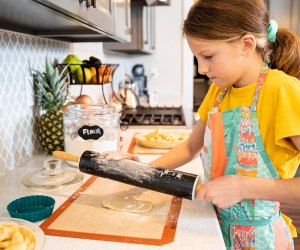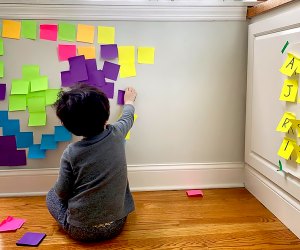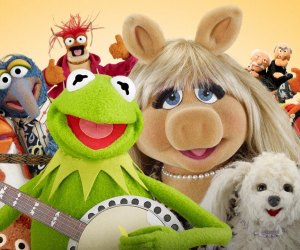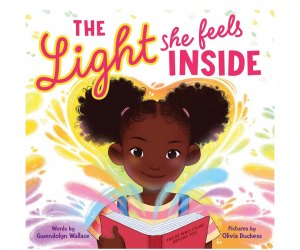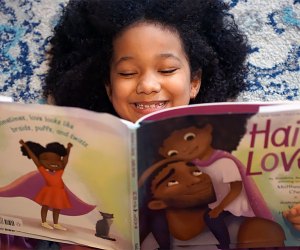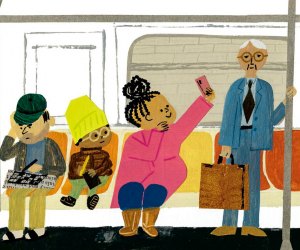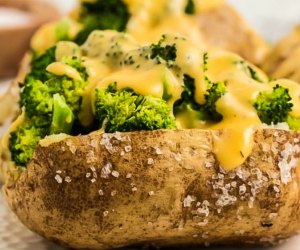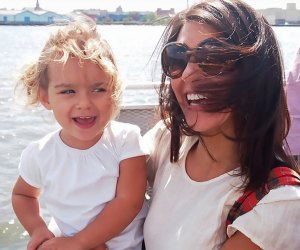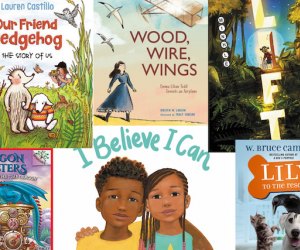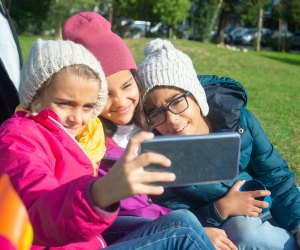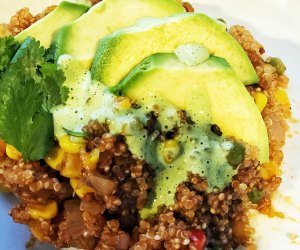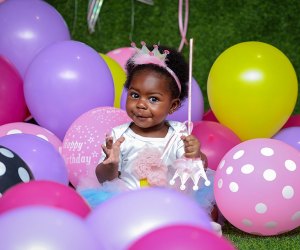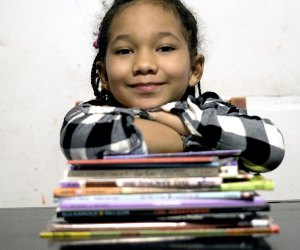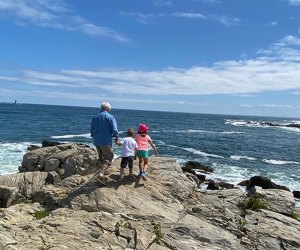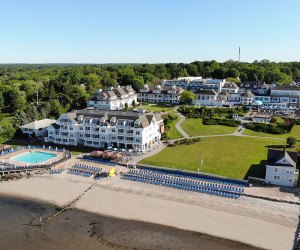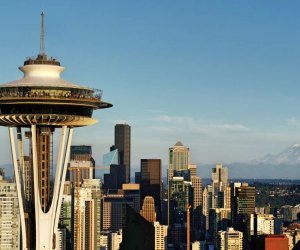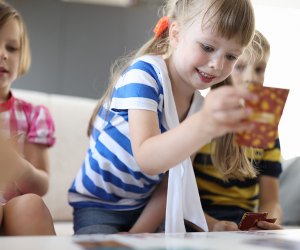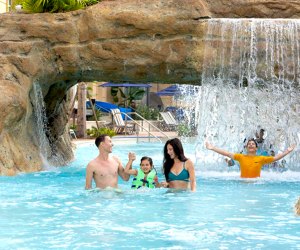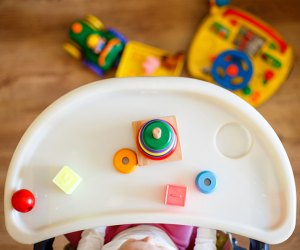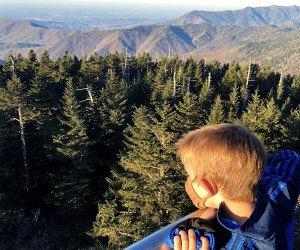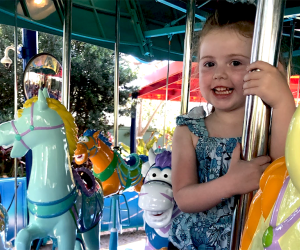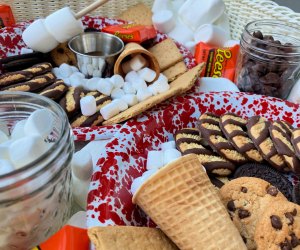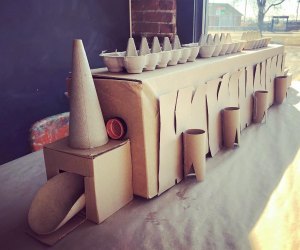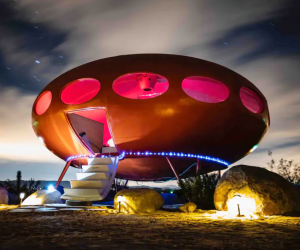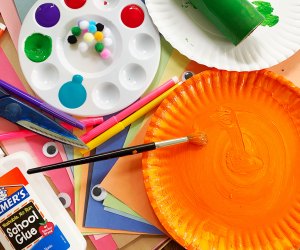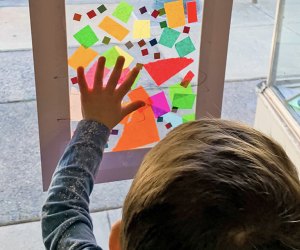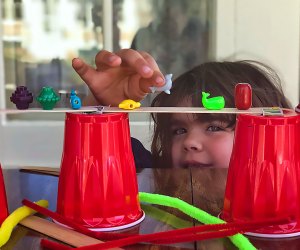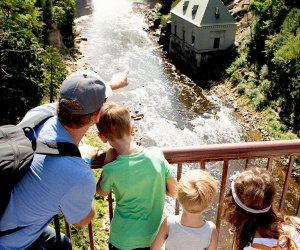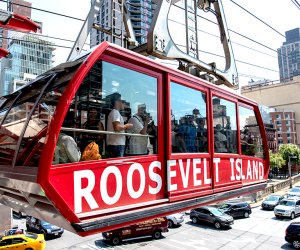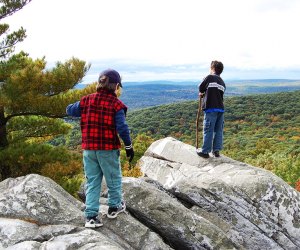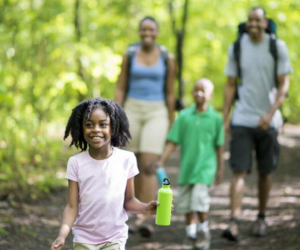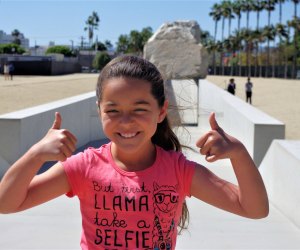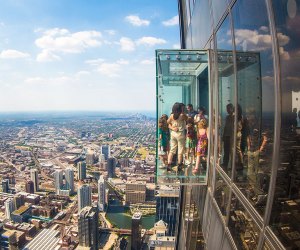Little Naturalists see Nature All Around in NYC
4/28/08
- By Anna Fader
 Walk through a park with your children and point out the different trees and their unique bark color, texture and patterns. Now that the flowers and leaves are emerging you can also help children observe the differences between the leaves and flowers of different species of trees. Bird life is everywhere. House sparrows nest in the pipes that hold up our street lights on every corner. Red-tail hawks are nesting in most of our parks, including inside Riverside Park at 81st street in a sweetgum tree along the on-ramp to the West Side Highway.
Walk through a park with your children and point out the different trees and their unique bark color, texture and patterns. Now that the flowers and leaves are emerging you can also help children observe the differences between the leaves and flowers of different species of trees. Bird life is everywhere. House sparrows nest in the pipes that hold up our street lights on every corner. Red-tail hawks are nesting in most of our parks, including inside Riverside Park at 81st street in a sweetgum tree along the on-ramp to the West Side Highway.
 Look for wildlife! During February and March a harbor seal hauled out on kayak docks north and south of the Boat Basin. I haven??™t seen him for 3 weeks and assume he has either gone up the Hudson to feed on the striped bass and American shad that are migrating back to the river from the ocean, or, if he is mature he might he might have joined a colony of other harbor seals during this breeding season. Amazing animal life lives in and around our city. You just need to keep your eyes open!
Buy a field guide or borrow one from your local library. There are small pocket guides to birds or trees or wildflowers and some great ones on insects and invertebrates. Field Guide to the Natural World of New York City is a comprehensive guide to our parks and wildlife.
Many children go through a bug stage. I remember my room covered in jars filled with invertebrates. I hated when living creatures died and so I would have to do some research to learn about their diet. Nature is enriching in many ways, but one thing it inevitably leads to is knowledge about other living organisms and about oneself. Caring for creatures other than ourselves enhances our own sense of humanity. E.O. Wilson, the renowned Harvard etymologist named this affinity for the natural world ???Biophilia.??? Wilson argues that humanity??™s love of living things stems from our having evolved as organisms connected in all ways to nature. No matter our age, when we go out into the natural world, whether in a city park, a suburban backyard, or the rural woods, we can connect to the natural world. During this historical time of anxiety over global warming and climate change, it can only help to know that we are introducing our children to nature so that when they come of age they will know more and care more about Mother Earth.
Leslie Day is author of Field Guide to the Natural World of New York City. She is a science teacher at The Elisabeth Morrow School in Englewood, New Jersey and an adjunct faculty member at Bank Street College of Education where she teaches Science for Teachers. Leslie has her doctorate in science education from Teachers College Columbia University. She and her husband, Brooklyn College biologist Jim Nishiura, have lived on a houseboat at the 79th Street Boat Basin in Riverside Park for thirty two years.
Click to buy Field Guide to the Natural World of New York City from Amazon.
Look for wildlife! During February and March a harbor seal hauled out on kayak docks north and south of the Boat Basin. I haven??™t seen him for 3 weeks and assume he has either gone up the Hudson to feed on the striped bass and American shad that are migrating back to the river from the ocean, or, if he is mature he might he might have joined a colony of other harbor seals during this breeding season. Amazing animal life lives in and around our city. You just need to keep your eyes open!
Buy a field guide or borrow one from your local library. There are small pocket guides to birds or trees or wildflowers and some great ones on insects and invertebrates. Field Guide to the Natural World of New York City is a comprehensive guide to our parks and wildlife.
Many children go through a bug stage. I remember my room covered in jars filled with invertebrates. I hated when living creatures died and so I would have to do some research to learn about their diet. Nature is enriching in many ways, but one thing it inevitably leads to is knowledge about other living organisms and about oneself. Caring for creatures other than ourselves enhances our own sense of humanity. E.O. Wilson, the renowned Harvard etymologist named this affinity for the natural world ???Biophilia.??? Wilson argues that humanity??™s love of living things stems from our having evolved as organisms connected in all ways to nature. No matter our age, when we go out into the natural world, whether in a city park, a suburban backyard, or the rural woods, we can connect to the natural world. During this historical time of anxiety over global warming and climate change, it can only help to know that we are introducing our children to nature so that when they come of age they will know more and care more about Mother Earth.
Leslie Day is author of Field Guide to the Natural World of New York City. She is a science teacher at The Elisabeth Morrow School in Englewood, New Jersey and an adjunct faculty member at Bank Street College of Education where she teaches Science for Teachers. Leslie has her doctorate in science education from Teachers College Columbia University. She and her husband, Brooklyn College biologist Jim Nishiura, have lived on a houseboat at the 79th Street Boat Basin in Riverside Park for thirty two years.
Click to buy Field Guide to the Natural World of New York City from Amazon.
You don't have to move to the suburbs to experience nature right in your own backyard. Here in New York City we have more nature all around us than most people realize. I asked Leslie Day, author of Field Guide to the Natural World of New York City, to give NYC parents some ideas for how to find, experience and learn about nature with kids in New York. Read her article below for NYC nature activities; and I highly recommend her book, with detailed information on the flora and fauna of NYC and where you can find them, as an excellent resource to help you get more nature out of NYC with kids!
OUR LATEST VIDEOS
Children and Nature
by Leslie Day
In his much acclaimed book, Last Child in the Woods: Saving Our Children From Nature-Deficit Disorder, Richard Louv points out that although children today may have knowledge of global warming, acid rain, and climate change, they actually spend very little time outdoors exploring nature. Research shows that today??™s generation of children spend less time outside in the natural world - and I don??™t mean as part of weekend sports teams, or weekday physical education classes- than their parents, and their parents spent less time just messing about in the parks, backyards or woods than their parents. With each generation, we seem to be losing touch with the beauty and enriching experience of the natural world.
Having grown up in New York City and Long Island in the 1940s and 1950s, I remember spending hours each day exploring the parks in my neighborhoods or my backyard in Long Island. One of my first memories is of waking my father up in the middle of the night during a raging thunderstorm to rescue a butterfly missing a wing that I had seen earlier in the day. I kept that butterfly in a jar next to my bed all night and when the sun came out I released it and watched it for hours. I was four. I also remember living across the street (now the Long Island Expressway, but back then, a small easier-to-cross road) from Corona Park and Meadow Lake in Forest Hills, Queens. There were huge weeping willow trees all along the edge of the lake and my friends and I would collect street tree leaves in autumn in shoe boxes. We would run to our favorite weeping willow tree and crawl in under the sweeping, delicate branches, hidden from the world and surrounded by a lacey golden green scrim. There we would lay out all the leaves we had collected and marvel at their beauty, shapes, colors and patterns.
Today I am a naturalist and a life-science teacher. The natural world continues to enrich my life every day and I am committed to helping children connect with it. We are so fortunate to have thousands of acres of city, state and federal parks right here in New York City. Our city is teeming with bird life, trees, gardens, interesting invertebrates, reptiles, fish and amphibians, all you need to know is how to find them.
Nature Activities for NYC Kids
Here are some activities you can do with your family during this glorious spring:
 Observe the birds! My husband and I noticed a mockingbird fly into a thick flowering shrub. I walked over (not too close) and there was a beautiful woven nest, and tucked neatly inside was the mockingbird.
Mommy mockingbird in her nest
Observe the birds! My husband and I noticed a mockingbird fly into a thick flowering shrub. I walked over (not too close) and there was a beautiful woven nest, and tucked neatly inside was the mockingbird.
Mommy mockingbird in her nest
 Look at the tiny leaves emerging from the leaf buds! Baby oak leaves, maples, lindens are all reaching out to the sun so that they can make food for themselves and the tree. The young oak leaves are particularly beautiful. You can still see the male flowers, called catkins, hanging below the emerging leaves.
Look at the tiny leaves emerging from the leaf buds! Baby oak leaves, maples, lindens are all reaching out to the sun so that they can make food for themselves and the tree. The young oak leaves are particularly beautiful. You can still see the male flowers, called catkins, hanging below the emerging leaves.
 Draw flowers! Carry colored pencils or crayons and paper with you. Everything is blooming in the city right now. Each species of tree produces uniquely shaped and colored flowers. Flowers are the reproductive parts of plants. The eggs inside the flower are fertilized and turn into seeds. Soon the fruit (ovary) of the flower will grow and grow, housing the seeds with the baby plants inside. The beautiful colors and fragrance of flowers attract pollinating animals, which help turn those eggs into seeds. Ornamental apple flowers and cherry blossoms now blooming all over the city, will produce crab apples and tiny cherries, loved by the birds.
Draw flowers! Carry colored pencils or crayons and paper with you. Everything is blooming in the city right now. Each species of tree produces uniquely shaped and colored flowers. Flowers are the reproductive parts of plants. The eggs inside the flower are fertilized and turn into seeds. Soon the fruit (ovary) of the flower will grow and grow, housing the seeds with the baby plants inside. The beautiful colors and fragrance of flowers attract pollinating animals, which help turn those eggs into seeds. Ornamental apple flowers and cherry blossoms now blooming all over the city, will produce crab apples and tiny cherries, loved by the birds.
 Observe the birds! My husband and I noticed a mockingbird fly into a thick flowering shrub. I walked over (not too close) and there was a beautiful woven nest, and tucked neatly inside was the mockingbird.
Mommy mockingbird in her nest
Observe the birds! My husband and I noticed a mockingbird fly into a thick flowering shrub. I walked over (not too close) and there was a beautiful woven nest, and tucked neatly inside was the mockingbird.
Mommy mockingbird in her nest
 Look at the tiny leaves emerging from the leaf buds! Baby oak leaves, maples, lindens are all reaching out to the sun so that they can make food for themselves and the tree. The young oak leaves are particularly beautiful. You can still see the male flowers, called catkins, hanging below the emerging leaves.
Look at the tiny leaves emerging from the leaf buds! Baby oak leaves, maples, lindens are all reaching out to the sun so that they can make food for themselves and the tree. The young oak leaves are particularly beautiful. You can still see the male flowers, called catkins, hanging below the emerging leaves.
Emegent red oak leaves and catkins
 Draw flowers! Carry colored pencils or crayons and paper with you. Everything is blooming in the city right now. Each species of tree produces uniquely shaped and colored flowers. Flowers are the reproductive parts of plants. The eggs inside the flower are fertilized and turn into seeds. Soon the fruit (ovary) of the flower will grow and grow, housing the seeds with the baby plants inside. The beautiful colors and fragrance of flowers attract pollinating animals, which help turn those eggs into seeds. Ornamental apple flowers and cherry blossoms now blooming all over the city, will produce crab apples and tiny cherries, loved by the birds.
Draw flowers! Carry colored pencils or crayons and paper with you. Everything is blooming in the city right now. Each species of tree produces uniquely shaped and colored flowers. Flowers are the reproductive parts of plants. The eggs inside the flower are fertilized and turn into seeds. Soon the fruit (ovary) of the flower will grow and grow, housing the seeds with the baby plants inside. The beautiful colors and fragrance of flowers attract pollinating animals, which help turn those eggs into seeds. Ornamental apple flowers and cherry blossoms now blooming all over the city, will produce crab apples and tiny cherries, loved by the birds.
Hawk family
 Walk through a park with your children and point out the different trees and their unique bark color, texture and patterns. Now that the flowers and leaves are emerging you can also help children observe the differences between the leaves and flowers of different species of trees. Bird life is everywhere. House sparrows nest in the pipes that hold up our street lights on every corner. Red-tail hawks are nesting in most of our parks, including inside Riverside Park at 81st street in a sweetgum tree along the on-ramp to the West Side Highway.
Walk through a park with your children and point out the different trees and their unique bark color, texture and patterns. Now that the flowers and leaves are emerging you can also help children observe the differences between the leaves and flowers of different species of trees. Bird life is everywhere. House sparrows nest in the pipes that hold up our street lights on every corner. Red-tail hawks are nesting in most of our parks, including inside Riverside Park at 81st street in a sweetgum tree along the on-ramp to the West Side Highway.
 Look for wildlife! During February and March a harbor seal hauled out on kayak docks north and south of the Boat Basin. I haven??™t seen him for 3 weeks and assume he has either gone up the Hudson to feed on the striped bass and American shad that are migrating back to the river from the ocean, or, if he is mature he might he might have joined a colony of other harbor seals during this breeding season. Amazing animal life lives in and around our city. You just need to keep your eyes open!
Buy a field guide or borrow one from your local library. There are small pocket guides to birds or trees or wildflowers and some great ones on insects and invertebrates. Field Guide to the Natural World of New York City is a comprehensive guide to our parks and wildlife.
Many children go through a bug stage. I remember my room covered in jars filled with invertebrates. I hated when living creatures died and so I would have to do some research to learn about their diet. Nature is enriching in many ways, but one thing it inevitably leads to is knowledge about other living organisms and about oneself. Caring for creatures other than ourselves enhances our own sense of humanity. E.O. Wilson, the renowned Harvard etymologist named this affinity for the natural world ???Biophilia.??? Wilson argues that humanity??™s love of living things stems from our having evolved as organisms connected in all ways to nature. No matter our age, when we go out into the natural world, whether in a city park, a suburban backyard, or the rural woods, we can connect to the natural world. During this historical time of anxiety over global warming and climate change, it can only help to know that we are introducing our children to nature so that when they come of age they will know more and care more about Mother Earth.
Leslie Day is author of Field Guide to the Natural World of New York City. She is a science teacher at The Elisabeth Morrow School in Englewood, New Jersey and an adjunct faculty member at Bank Street College of Education where she teaches Science for Teachers. Leslie has her doctorate in science education from Teachers College Columbia University. She and her husband, Brooklyn College biologist Jim Nishiura, have lived on a houseboat at the 79th Street Boat Basin in Riverside Park for thirty two years.
Click to buy Field Guide to the Natural World of New York City from Amazon.
Look for wildlife! During February and March a harbor seal hauled out on kayak docks north and south of the Boat Basin. I haven??™t seen him for 3 weeks and assume he has either gone up the Hudson to feed on the striped bass and American shad that are migrating back to the river from the ocean, or, if he is mature he might he might have joined a colony of other harbor seals during this breeding season. Amazing animal life lives in and around our city. You just need to keep your eyes open!
Buy a field guide or borrow one from your local library. There are small pocket guides to birds or trees or wildflowers and some great ones on insects and invertebrates. Field Guide to the Natural World of New York City is a comprehensive guide to our parks and wildlife.
Many children go through a bug stage. I remember my room covered in jars filled with invertebrates. I hated when living creatures died and so I would have to do some research to learn about their diet. Nature is enriching in many ways, but one thing it inevitably leads to is knowledge about other living organisms and about oneself. Caring for creatures other than ourselves enhances our own sense of humanity. E.O. Wilson, the renowned Harvard etymologist named this affinity for the natural world ???Biophilia.??? Wilson argues that humanity??™s love of living things stems from our having evolved as organisms connected in all ways to nature. No matter our age, when we go out into the natural world, whether in a city park, a suburban backyard, or the rural woods, we can connect to the natural world. During this historical time of anxiety over global warming and climate change, it can only help to know that we are introducing our children to nature so that when they come of age they will know more and care more about Mother Earth.
Leslie Day is author of Field Guide to the Natural World of New York City. She is a science teacher at The Elisabeth Morrow School in Englewood, New Jersey and an adjunct faculty member at Bank Street College of Education where she teaches Science for Teachers. Leslie has her doctorate in science education from Teachers College Columbia University. She and her husband, Brooklyn College biologist Jim Nishiura, have lived on a houseboat at the 79th Street Boat Basin in Riverside Park for thirty two years.
Click to buy Field Guide to the Natural World of New York City from Amazon. 



